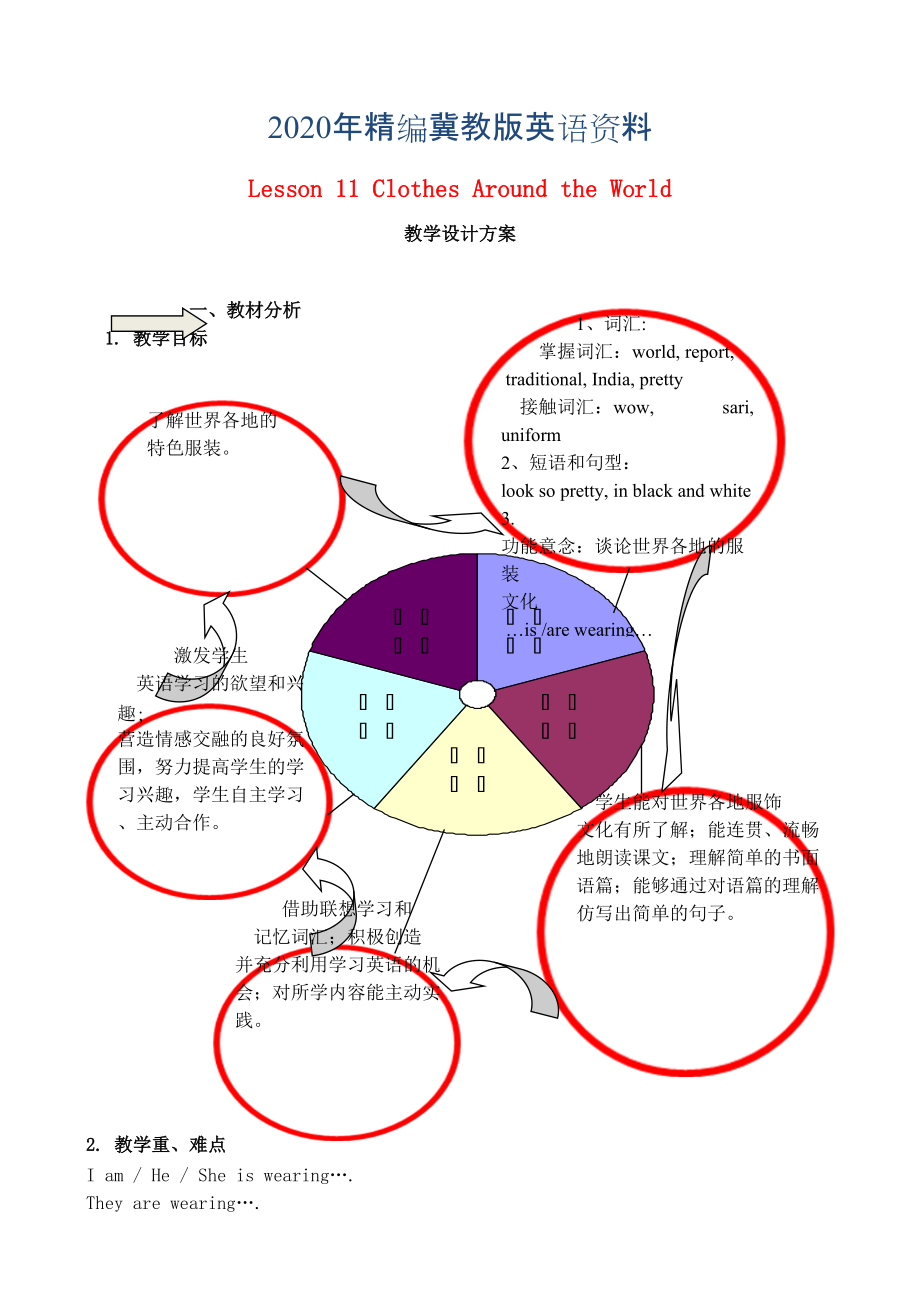《2020年【冀教版】七年級上冊:Unit 2 Lesson 11 Clothes around the World教案》由會員分享��,可在線閱讀��,更多相關(guān)《2020年【冀教版】七年級上冊:Unit 2 Lesson 11 Clothes around the World教案(3頁珍藏版)》請?jiān)谘b配圖網(wǎng)上搜索����。
1�、2020年精編冀教版英語資料
Lesson 11 Clothes Around the World
教學(xué)設(shè)計(jì)方案
1、詞匯:
掌握詞匯:world, report,
traditional, India, pretty
接觸詞匯:wow, sari, uniform
2�、短語和句型:
look so pretty, in black and white
3. 功能意念:談?wù)撌澜绺鞯氐姆b
文化
…is /are wearing…
… look/ looks… in …
一、教材分析
1. 教學(xué)目標(biāo)
了解世界各
2��、地的特色服裝�。
激發(fā)學(xué)生
英語學(xué)習(xí)的欲望和興趣; 營造情感交融的良好氛圍,努力提高學(xué)生的學(xué)習(xí)興趣�����,學(xué)生自主學(xué)習(xí)�����、主動合作。
學(xué)生能對世界各地服飾
文化有所了解����;能連貫、流暢
地朗讀課文����;理解簡單的書面
語篇;能夠通過對語篇的理解
仿寫出簡單的句子�。
借助聯(lián)想學(xué)習(xí)和
記憶詞匯�����;積極創(chuàng)造
并充分利用學(xué)習(xí)英語的機(jī)會���;對所學(xué)內(nèi)容能主動實(shí)踐��。
2. 教學(xué)重�、難點(diǎn)
I am / He / She is wearing….
They are we
3����、aring….
My/ His/ Her/ Your/ Their… look / looks….
I / They look … (in my / their…).
He / She looks… (in his/her …).
Adjectives: colourful, beautiful, traditional, pretty, nice
二、學(xué)生學(xué)情分析
學(xué)生在學(xué)習(xí)顏色和服裝的一些詞匯的基礎(chǔ)上,也掌握了一些有關(guān)詞匯和服裝的文化背景知識����。對于世界各地特色服飾學(xué)生平時(shí)有所了解,也很感興趣����。
三、教學(xué)準(zhǔn)備
教師準(zhǔn)備
C
4�����、AI 課件
具有中國特色的服飾��,或服飾圖片�����。(男子的中山裝��,女子的旗袍等���。)
學(xué)生準(zhǔn)備
在網(wǎng)上搜索有關(guān)世界各地服飾的資料���。
帶一張服裝穿著有特色的全家福照片����。
預(yù)習(xí)課文�。
四、教學(xué)步驟
Step 1. Class Opening and Review.
Chant colorful clothes together. Show a picture of many people wearing their national clothes. Ask Ss if they know these clothes. Ask them to describe
5�����、 the colours of the clothes(Two examples are given to help Ss know how to express the picture through PPT).
【設(shè)計(jì)思路】以chant的形式開始課程能夠活躍課堂氣氛��,通過圖片和練習(xí)自然過渡到新授課的內(nèi)容���。
Step 2. Introduction.
Show the teaching content to Ss, make sure they get the general ideas to the content of this lesson.
【設(shè)計(jì)思路】在每節(jié)課新授課開始
6�����、前給學(xué)生展示本節(jié)課的重難點(diǎn),有助于學(xué)生在學(xué)習(xí)中做到心中有數(shù)���,也利于與之后的鞏固總結(jié)環(huán)節(jié)相對應(yīng)���。
Step 3. New words.
1. Show the new words in the screen. Teach Ss the pronunciation, parts of speech and the meanings of the new words.
2. Check out the vocabulary. Ask Ss to listen and circle the words they hear (show the new words in the screen).
7、
3. Finish Activity 2 in Let’s Do It!
【設(shè)計(jì)思路】 本課的新授詞匯比較集中�����,數(shù)量也較多。因此在接觸語篇之前��,集中幫助學(xué)生掌握詞匯的發(fā)音��、含義有助于之后教學(xué)活動的展開���,降低學(xué)生學(xué)習(xí)的難度���。之后通過聽力檢測詞匯學(xué)習(xí)的效果并自然引出下一環(huán)節(jié)內(nèi)容。
Step 4. Practice.
Ask Ss to make a group and take out their family photos, and use the target language (show it in the screen ) to talk about their family p
8����、hotos.
【設(shè)計(jì)思路】 此部分內(nèi)容是在顏色詞匯掌握的基礎(chǔ)上的情景應(yīng)用,幫助學(xué)生在使用中內(nèi)化所學(xué)知識��,達(dá)到熟練掌握��。教師也可拿出自己的全家福�����,參與活動�,提高學(xué)生參與的積極性���。
Step 5. Reading.
Do Activity 3 in Let’s Do It! Read the passage and fill in the blanks.
Step 6. Culture Tips.
Discuss the questions and talk about your ideas about clothes culture!
1. Do all people wear
9、 uniforms for work or school?
2. Can men wear skirts?
3. Do people wear traditional clothes in your hometown? Can you describe it?
4. Do you know any traditional clothes people wear in China? Show them to your partner.
【設(shè)計(jì)思路】 培養(yǎng)學(xué)生的文化意識是新課程標(biāo)準(zhǔn)的五維目標(biāo)之一��。本環(huán)節(jié)體現(xiàn)教師對教材的重組���。將Let’s Do It! 中的活動1和4結(jié)合起來����,讓學(xué)生通過回答
10��、問題的方式�����,自己感悟在本課中所學(xué)習(xí)的服飾文化知識���,并同過合作和分享的模式,了解更多世界各地的特色服裝���。
Step 7. Conclusion.
Make Ss evaluate themselves by discussing what they have learnt in this class. Help Ss know the key content of this lesson.
【設(shè)計(jì)思路】幫助學(xué)生建立起對自己在每節(jié)課中的學(xué)習(xí)進(jìn)行評價(jià)和整理的好習(xí)慣��。也可減少學(xué)生間的學(xué)習(xí)效果的個體差異�。
Step 8. Homework.
1. Learn the new words and expressions by heart.
2. Write some sentences to describe some traditional clothes in China.
3. Prepare for the next lesson.
五、教學(xué)反思
學(xué)生是學(xué)習(xí)的主體����,教師在組織課堂活動時(shí)應(yīng)該鼓勵和培養(yǎng)學(xué)生在學(xué)習(xí)過程中積極合作、互相學(xué)習(xí)的態(tài)度和習(xí)慣�����。在設(shè)計(jì)課堂活動時(shí)��,既要有緊貼學(xué)生日常生活的內(nèi)容��,也要有帶給學(xué)生新鮮感的材料�����。
 2020年【冀教版】七年級上冊:Unit 2 Lesson 11 Clothes around the World教案
2020年【冀教版】七年級上冊:Unit 2 Lesson 11 Clothes around the World教案

